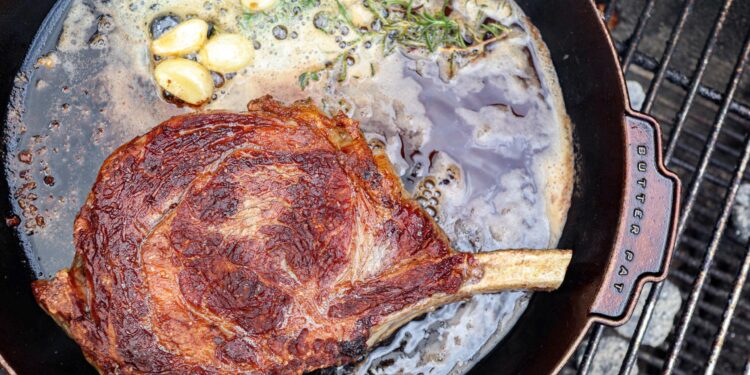Exploring the Art of Butter Basting: Is It Worth the Hype?
The culinary community is abuzz with discussions about the optimal way to prepare a steak, and one method that stands out is butter basting. Advocates claim this technique enhances both flavor and moisture, while critics question its practicality and effect on meat quality. As grilling season approaches, many home chefs are left pondering: does butter basting truly make a difference? In this article, we will investigate the science behind this method, gather insights from culinary experts, and evaluate its advantages and disadvantages to help you determine if it should be part of your cooking repertoire.
Understanding Butter Basting: The Science of Flavor and Texture
Basting a steak with butter transcends mere culinary fashion; it is rooted in scientific principles. When you introduce a tablespoon of butter into a heated pan, it melts into a luscious liquid that not only amplifies the steak’s inherent flavors but also contributes to an appealing texture. As the melted butter mingles with the juices released by the meat, it facilitates flavor development through what’s known as the Maillard reaction. This chemical process occurs at elevated temperatures and results in complex flavor compounds forming on the surface of your steak. Consequently, this technique helps create an appetizingly crispy crust while ensuring that the interior remains delectably tender.
Additionally, basting plays a vital role in regulating cooking temperatures while adding moisture back into your steak. By repeatedly spooning melted butter over your meat during cooking, you establish an environment conducive to self-basting that locks in essential juices. This not only enriches taste but also aids in achieving that coveted medium-rare finish. Here are some key benefits associated with basting:
- Flavor Boost: Infuses steaks with rich buttery notes.
- Crispy Texture: Results in an appealing outer crust paired with juicy insides.
- Moisure Preservation: Seals juices for enhanced tenderness.
Insights from Chefs on Butter Basting for Home Cooks
Culinary professionals agree that using butter for basting not only intensifies flavor but also yields a succulent texture often hard to achieve through conventional methods alone. By incorporating melted butter infused with garlic cloves or fresh herbs like rosemary or thyme, home cooks can elevate their meals to gourmet standards without much effort. Furthermore, this technique allows for meticulous control over cooking processes—enabling cooks to keep track of internal temperatures while maintaining moisture levels effectively—bringing out rich flavors often lost when using dry heat methods.
The advantages extend beyond just taste; nutritionists point out that moderate use of butter can enhance meal quality by providing essential vitamins along with healthy fats beneficial for overall well-being when consumed judiciously. Here’s a brief overview highlighting why you might consider adopting this technique:
- Flavor Enhancement: Adds depth and richness to each bite.
- Tenderness Improvement: Ensures juiciness throughout every slice.
- Culinary Creativity: Opens doors for unique infusions using various herbs or spices.
- Easier Temperature Management:Aids in reaching desired doneness more accurately.
| Benefits of Butter Basing | Description |
|---|---|
| Flavor Profile | Delivers savory richness complementing beef perfectly . |
| >Tenderness << / td >> << td >>Encourages moist , juicy textures .<< / td >> << / tr >> |
Tips for Mastering Butter-Basted Steak at Home
If you’re aiming for perfection when preparing your own butter-basted steak at home , success lies within both skillful techniques as well as selecting high-quality ingredients . Start off by choosing premium cuts such as ribeye or sirloin which possess good marbling—this enhances both flavor & tenderness significantly! Before searing , allow steaks time reach room temperature ; doing so promotes even cooking throughout each piece . Opt instead heavy skillets (preferably cast iron) since they retain heat exceptionally well ! During cook time , add generous amounts unsalted stick alongside aromatics like crushed garlic cloves & fresh herbs (thyme/rosemary) ; these additions will further enrich overall profile whilst enhancing crust formation!
< p>Baste continuously throughout process : scoop up melted goodness then drizzle over sizzling surface allowing flavors penetrate deeply! Begin initially high heat creating beautiful golden brown exterior before reducing temp gradually until desired doneness achieved! Keep these practical tips handy next time around :
- <
- < strong >Choose unsalted varietiesto manage saltiness effectively.< li />
- < strong >Utilize thermometerfor precise monitoring purposes.< li />
- < strong >Allow resting period post-cookingof approximately five-ten minutes ensuring maximum juiciness retained.< li />
< ul />Final Thoughts
The ongoing discussion regarding whether or not one should employ buttery baste techniques continues captivating food lovers everywhere—from seasoned chefs down aspiring amateurs alike! While numerous culinary authorities advocate its ability impart richness alongside delightful finishes onto meats others argue against necessity especially those who prefer savoring natural essence found within top-tier cuts themselves ! Ultimately effectiveness boils down personal preference combined specific cut being prepared ! Whether you’re experienced grill master novice cook understanding nuances surrounding various methods—including application utilizing flavorful fats like BUTTER —can undoubtedly enhance overall experience enjoyed during mealtime gatherings together family friends alike ! So next time fire up grill consider giving classic approach try yourself see if lives up mouthwatering reputation claims!






























